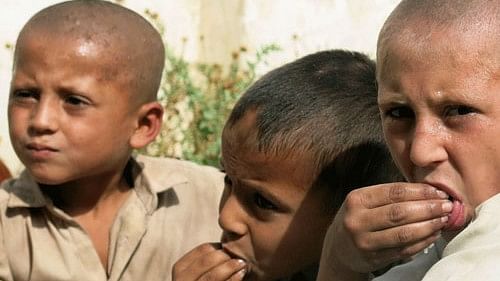
Representative image showing children.
Credit: Reuters File Photo
New Delhi: Children living in India's hills and mountains are at an increased risk of stunted growth, with the risk increasing with rise in altitude, according to new research published in the British Medical Journal Nutrition, Prevention & Health.
Analysing data of more than 1.65 lakh children under five years of age, researchers observed that stunting was more common among those born as a third or later child to parents, and those having a small size at birth.
Data was included from the 2015-16 National Family Health Survey (NFHS-4) for analysis. The WHO standards were used to define stunting.
The researchers, including those from Manipal Academy of Higher Education, Manipal, suggested that continuous exposure to high altitude environment can reduce appetite, and limit oxygen and nutrient absorption, even as, they said, a direct causal link was not established in the observational study.
The team also said that food insecurity in hilly and mountainous regions tends to be more, arising out of lower crop yields and harsher climate. Providing access to healthcare in these regions, including implementing nutritional programmes, is challenging, they said.
The overall prevalence of stunting among these children was found to be 36 per cent. Prevalence was higher among children aged 1.5-5 years (41 per cent) than among those under 1.5 years of age (27 per cent).
In their analysis, the researchers found that 98 per cent of the children lived at altitudes less than 1,000 metres above sea level, and 1.4 per cent lived between 1,000 and 2,000 metres above sea level, and 0.2 per cent lived at more than 2000 metres above sea level.
Children living at locations 2,000 metres or more above sea level were found to be 40 per cent more at risk of stunting than those living 1,000 metres above sea level.
The analysis also found that stunting was prevalent in 44 per cent of thirdborns or children higher in birth order among siblings, compared to 30 per cent in firstborns. Stunting rates were still higher (45 per cent) among children who were small or very small at birth.
The researchers found that mother's education levels was an influential factor, with prevalence in stunted growth falling with rising educational attainment. They also found that post-pregnancy care, including clinic visits, vaccinations, and health supplements, and being located closer to health facilities, were protective factors.
The authors found that not belonging to a particular caste or indigenous tribe too was a protective factor.
"A multipronged approach should combine reproductive health initiatives, women's nutrition programmes, infant and young child feeding interventions, and food security measures," the authors wrote.
"Continued research, monitoring, and evaluation will be key to guide evidence-based policies and targeted action to ensure every Indian child has the opportunity for healthy growth and development," the researchers wrote.